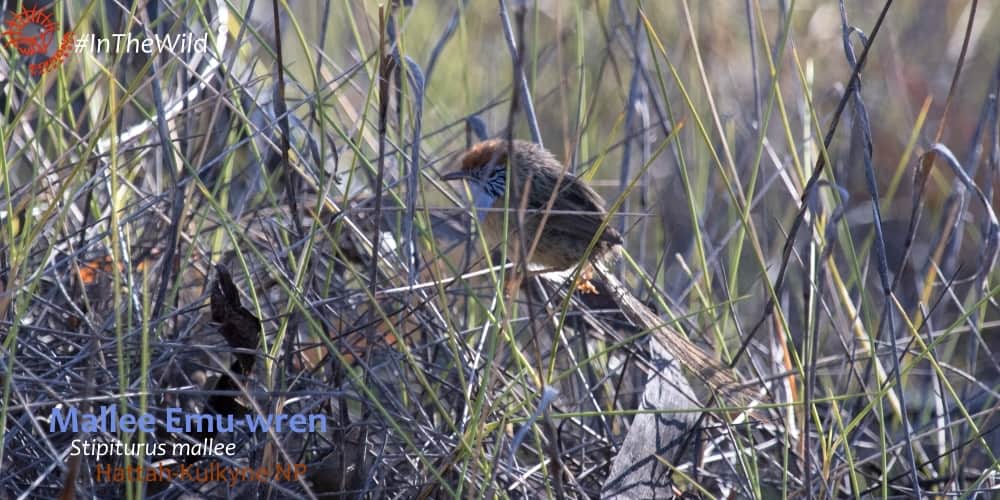On our Mungo Outback Journey tour, our Wildlife Guides can’t wait to walk into The Mallee.

What is The Mallee? Mallee means many things. At Echidna Walkabout Nature Tours mallee means sunny, sandy wild country brimming with colourful wildlife.
..
Mallee trees are Eucalyptus trees that have a particular growth habit – see Mallee Habit below. They have beautiful names, some bestowed by their location: Kamarooka Mallee, Dumosa Mallee, Kangaroo Island Mallee, Port Lincoln Mallee, Kingscote Mallee; some from their appearance: Blue, Green, White, Red, Yellow & Grey Mallee, Curly Mallee, Acorn Mallee and the gorgeous Silver Princess; and loveliest of all, the Aboriginal names: Gilja, Gungurru and Yorrell. The word Mallee itself is of Aboriginal origin.

..
Mallee habit is a style of tree growth that is multi-stemmed, like a shrub, but bigger. Under the ground there is a special structure – the Mallee Root – which is a lignotuber. The lignotuber stores energy, and can regenerate the tree if the top is damaged.
Imagine a tree, buried to the top of the trunk: the lignotuber is the trunk, underground, and the branches are above ground.

This design is very sensible for trees growing in hot, dry, fire-prone areas.

Image by Wildlife Guide Michael Williams ITS A WILDLIFE Photography
..
The Mallee is also the region of Australia where these trees grow. The dark green areas on the map below are the main regions known as The Mallee.

The north-west of Victoria, the south of South Australia and the south-east of Western Australia are The Mallee Region. The soil is sandy and has few, if any, rivers. The land is flat and semi-desert. Rainfall is low – between 250mm and 400mm annually.
Wildlife Guide Roger grew up in The Mallee, on a sheep and wheat farm between Pinaroo, SA and Murrayville, VIC. The Big Desert was his backyard, and Mallee Ringneck Parrots were his first bird memories.

image by Michael Williams ITS A WILDLIFE photography
..
We love taking tours into mallee forest because it is rich, colourful and full of native birds and wildlife. Mallee trees flower heavily, and get lots of sun – so insects and birds flock to them. Their tree tops are only 6 metres up, sometimes less, so its easy to see the wildlife of the ground, the lower canopy and the upper canopy in one glance!
Wildlife of the Mallee seen on Mungo Outback Journey tour:

image by Wildlife Guide Martin Maderthaner
..
MALLEE BIRDS:
Mallee Emu-wren*
Emu
Mallee Ringneck Parrot
Regent Parrot*
Crested Bellbird
Yellow-plumed Honeyeater
Striated Grasswren*
Spiny-cheeked Honeyeater
Major Mitchell’s Cockatoo*
Hooded Robin*
Wedge-tailed Eagle
Jacky Winter
Red-capped Robin
Mulga Parrot
Black-eared Cuckoo
Red-backed Kingfisher
Splendid Fairy-wren
Chestnut-crowned Babbler
Chestnut Quail-thrush*

Image by Wildlife Guide Martin Maderthaner
..
Gilbert’s Whistler*
White-browed, Masked, White-breasted and Black-faced Woodswallows
Southern Scrub-robin*
Pied Butcherbird

Image by Wildlife Guide Michael Williams ITS A WILDLIFE Photography
..
*Many of the mallee birds are endangered or threatened. BirdLife Australia* have a conservation action plan to help protect these birds, but they need support. Please read more about the mallee birds and their challenges here.

Image by Wildlife Guide Janine Duffy
..
MALLEE MAMMALS & REPTILES:
Western Grey Kangaroo
Red Kangaroo

Image by Wildlife Guide Roger Smith
..
Central Bearded Dragon
Mallee Military Dragon
Bynoe’s Gecko
Regal Striped Skink
Shingleback
Sand Goanna

Image by Wildlife Guide Janine Duffy
..
We love walking through the mallee on our Mungo Outback Journey. It is one of the most important and exciting ecosystems we experience on this private tour.
Australia’s winter (northern hemisphere summer June, July, August) is a great time to visit the Mallee. Read a suggested trip plan here.

Image by Michael Williams ITS A WILDLIFE Photography
…………………………………..
NOTES & REFERENCES:
Echidna Walkabout’s principal Janine Duffy is a proud member of BirdLife Australia. Echidna Walkabout makes regular donations to this important champion of Australia’s birdlife.
http://www.birdlife.org.au/
http://www.birdlife.org.au/projects/threatened-mallee-birds
If you are looking for sensitive, quality wildlife photography please consider ITS A WILDLIFE photography. Photographer Michael had many years experience all over the world, and knew how to get the best images without disturbing or stressing the animals. ITS A WILDLIFE have a big range of stock images available for purchase.

